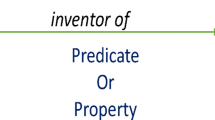Abstract
How to query Linked Data effectively is a challenge due to its heterogeneous datasets. There are three types of heterogeneities, i.e., different structures representing entities, different predicates with the same meaning and different literal formats used in objects. Approaches based on ontology mapping or Information Retrieval (IR) cannot deal with all types of heterogeneities. Facing these limitations, we propose a hierarchical multi-hop language model (HMPM). It discriminates among three types of predicates, descriptive predicates, out-associated predicates and in-associated predicates, and generates multi-hop models for them respectively. All predicates’ similarities between the query and entity are organized into a hierarchy, with predicate types on the first level and predicates of this type on the second level. All candidates are ranked in ascending order. We evaluated HMPM in three datasets, DBpedia, LinkedMDB and Yago. The results of experiments show that the effectiveness and generality of HMPM outperform the existing approaches.
Similar content being viewed by others
References
HARTIG O, BIZER C, FREYTAG J C. Executing SPARQL queries over the web of Linked Data [C]//Proceedings of the 8th International Semantic Web Conference. Chantilly, VA, USA: Springer, 2009: 293–309.
LADWIG G, TRAN T. Linked Data query processing strategies [C]//Proceedings of the 9th International Semantic Web Conference. Shanghai, China: Springer, 2010: 453–469.
HARTIG O. Zero-knowledge query planning for an iterator implementation of link traversal based query execution [C]//Proceedings of the 8th Extended Semantic Web Conference. Heraklion, Crete, Greece: Springer, 2011: 154–169.
HARTH A, HOSE K, KARNSTEDT M, et al. Data summaries for on-demand queries over Linked Data [C]//Proceedings of the 19th International Conference on World Wide Web. Raleigh, NC, USA: DBLP, 2010: 411–420.
PHAM M D, BONCZ P. Exploiting emergent schemas to make RDF systems more efficient [C]//Proceedingsof the 15th International Sematic Web Conference. Kobe, Japan: Springer, 2016: 463–479.
RAHM E, BERNSTEIN P A. A survey of approaches to automatic schema matching [J]. The International Journal on Very Large Data Bases, 2001, 10(4): 334–350.
DOAN A H, HALEVY A Y. Semantic-integration research in the database community: A brief survey [J]. American Association for Artificial Intelligence, 2005, 26(1): 83–94.
DUAN S, FOKOUE A, SRINIVAS K. One size does not fit all: Customizing ontology alignment using user feedback [C]// Proceedings of the 10th International Semantic Web Conference. Shanghai, China: Springer, 2010: 177–192.
HU W, QU Y Z. Falcon-AO: A practical ontology matching system [J]. Web Semantics: Science, Services and Agents on the World Wide Web, 2008, 6(3): 237–239.
ZHOU X, GAUGAZ J, BALKE W T, et al. Query relaxation using malleable schemas [C]//Proceedings of the 2007 ACM SIGMOD International Conference on Management of Data. Beijing, China: ACM, 2007: 545–556.
ELBASSUONI S, RAMANATH M, SCHENKEL R, et al. Language-model-based ranking for queries on RDFgraphs [C]//Proceedings of the 18th ACM Conference on International and Knowledge Management. Hong Kong, China: ACM, 2009: 977–986.
NEUMAYER R, BALOG K, NØRV˚AG K. On the modeling of entities for ad-hoc entity search in the web of data [C]//Proceedings of the 34th European Conference on IR Research. Barcelona, Spain: Springer, 2012: 133–145.
HERZIG D M, TRAN T. Heterogeneous web data search using relevance-based on the fly data integration [C]//Proceedings of the 21st International Conference on World Wide Web. Lyon, France: ACM, 2012: 141–150.
PONTE J M, CROFT W B. A language modeling approach to information retrieval [C]//Proceedings of the 21st Annual International ACM SIGIR Conference on Research and Development in Information Retrieval. Melbourne, Australia: ACM, 1998: 275–281.
OGILVIE P, CALLAN J. Hierarchical language models for XML component retrieval [C]//Proceedings of the 3rd International Conference on Initiative for the Evaluation of XML Retrieval. Dagstuhl Castle, Germany: Springer, 2004: 224–237.
BLEI D M, NG A Y, JORAN M I. Latent dirichlet allocation [J]. Journal of Machine Learning Research, 2003, 3: 993–1022.
Author information
Authors and Affiliations
Corresponding author
Rights and permissions
About this article
Cite this article
Li, J., Wang, W. & Wang, J. Querying Linked Data Based on Hierarchical Multi-Hop Ranking Model. J. Shanghai Jiaotong Univ. (Sci.) 23, 568–576 (2018). https://doi.org/10.1007/s12204-018-1976-z
Received:
Published:
Issue Date:
DOI: https://doi.org/10.1007/s12204-018-1976-z




